Micca Speck G3/4K Digital Media Player
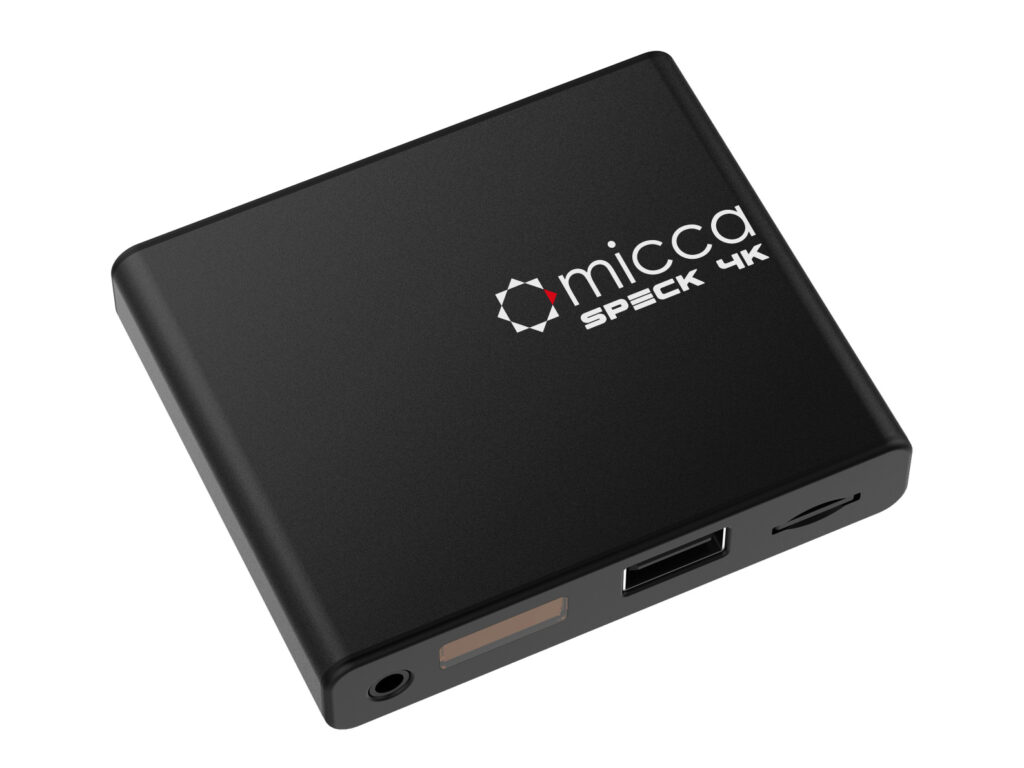
Make your TV smarter
The Micca Speck G3 and Speck 4K media players enhance any TV with the ability to play videos, music, and photo slideshows from a USB drive or MicroSD Card! It’s so simple and intuitive – anyone can use it. The Micca Speck G3/4K is amazingly compact and affordable, get one for each TV in the house!
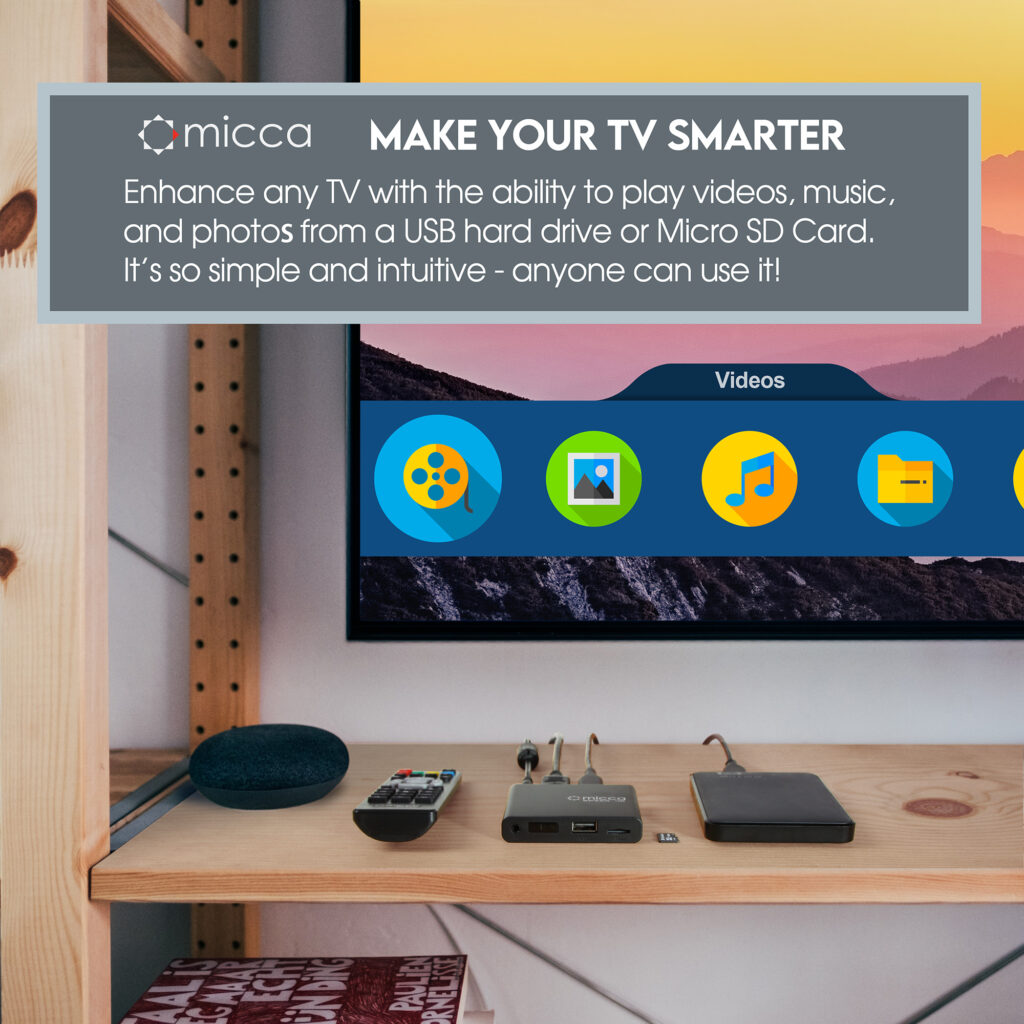
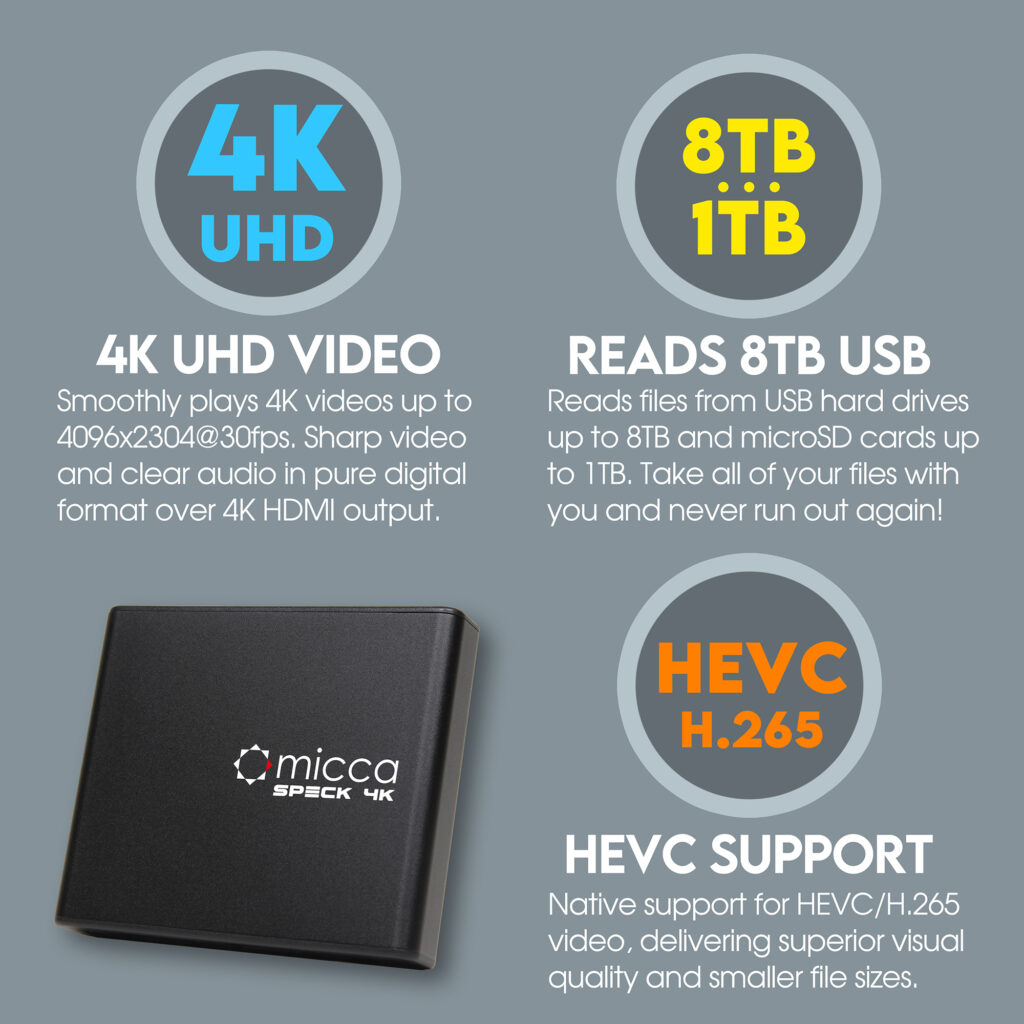
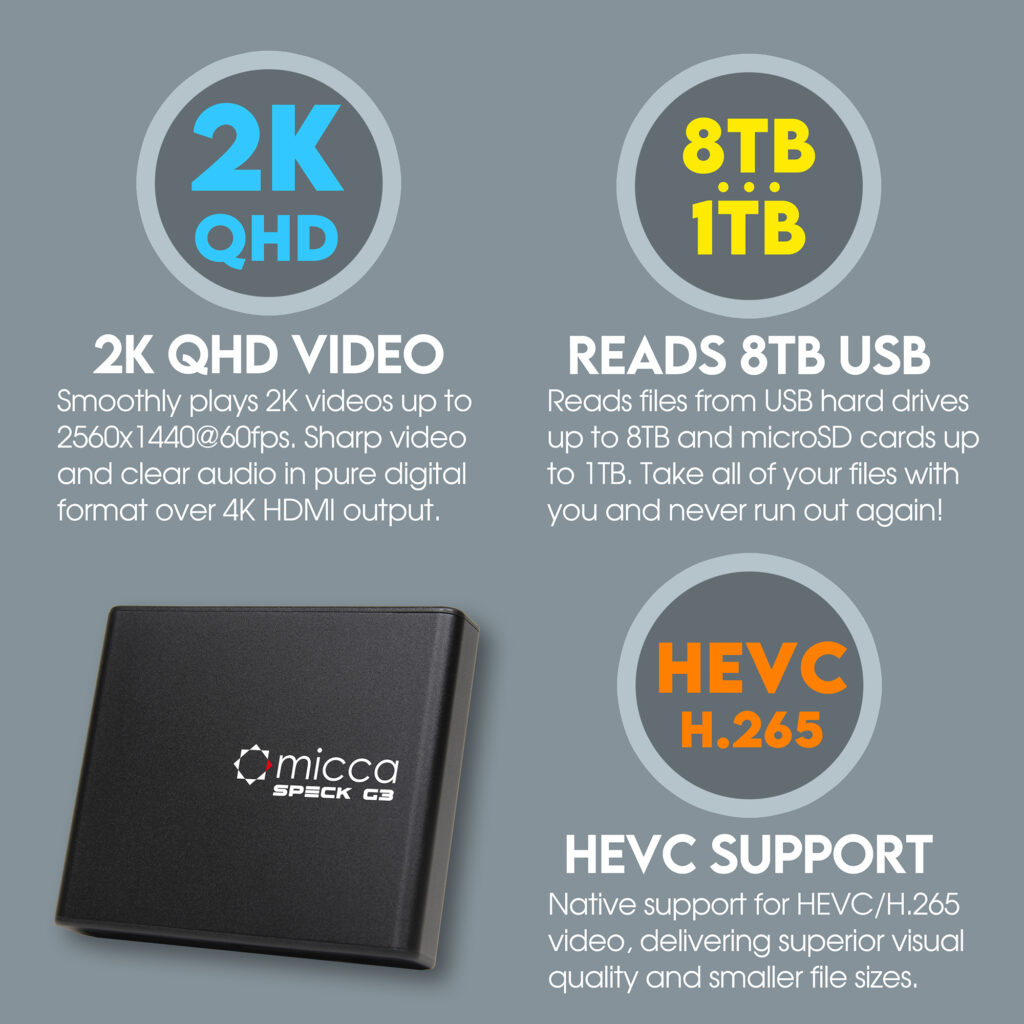

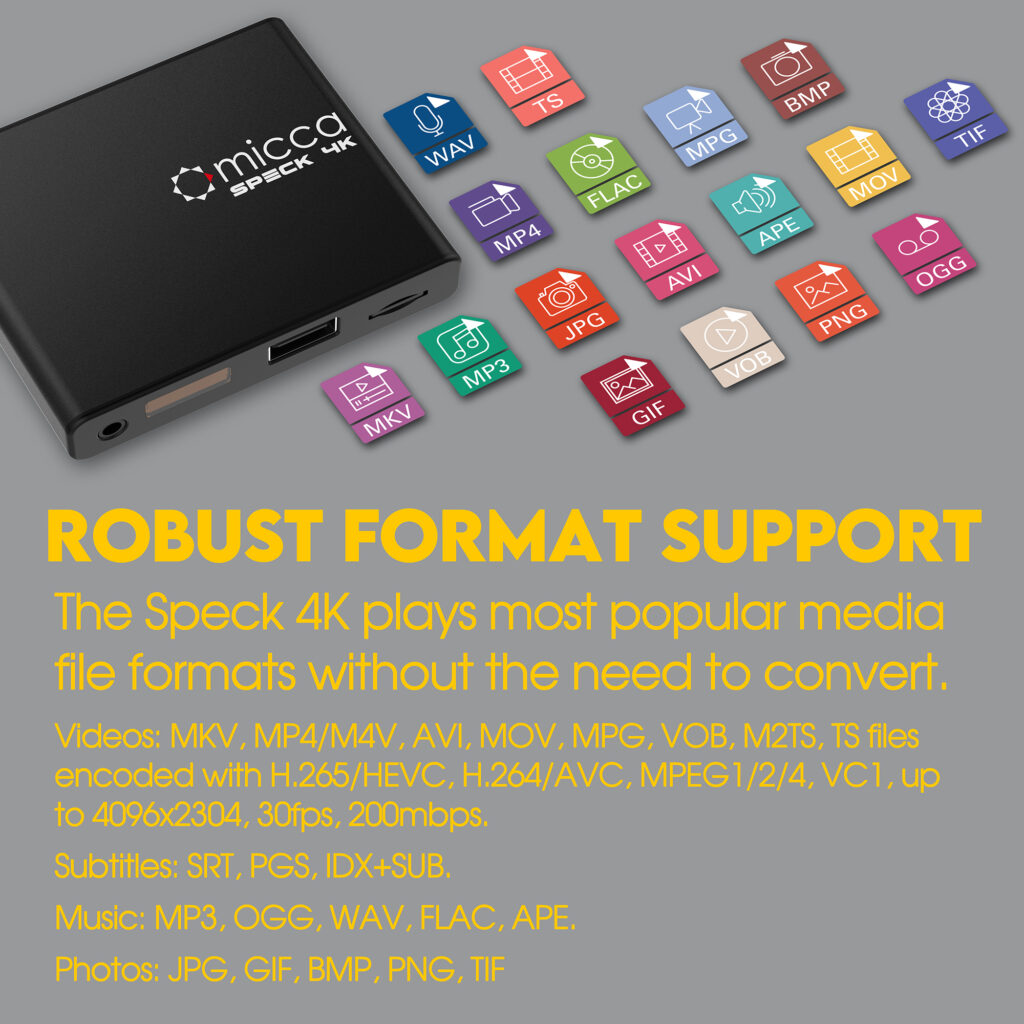
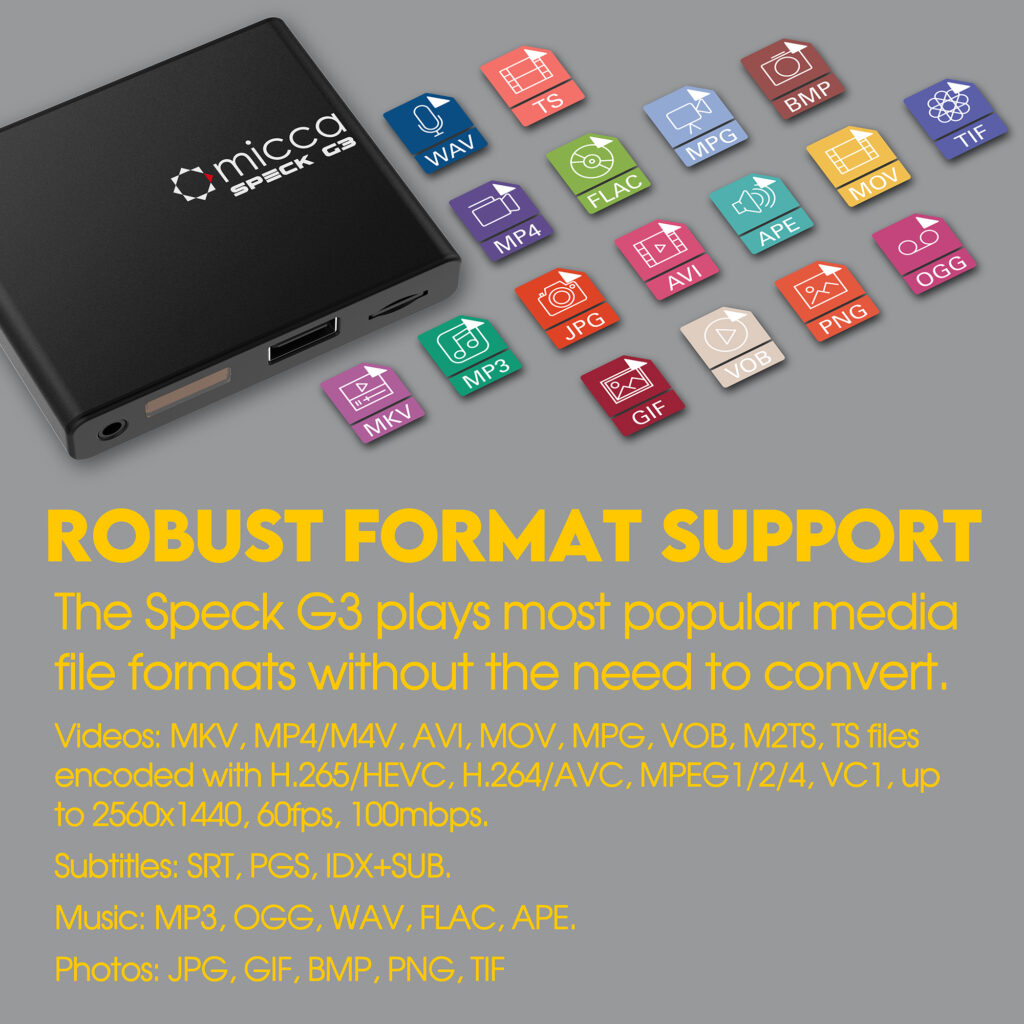
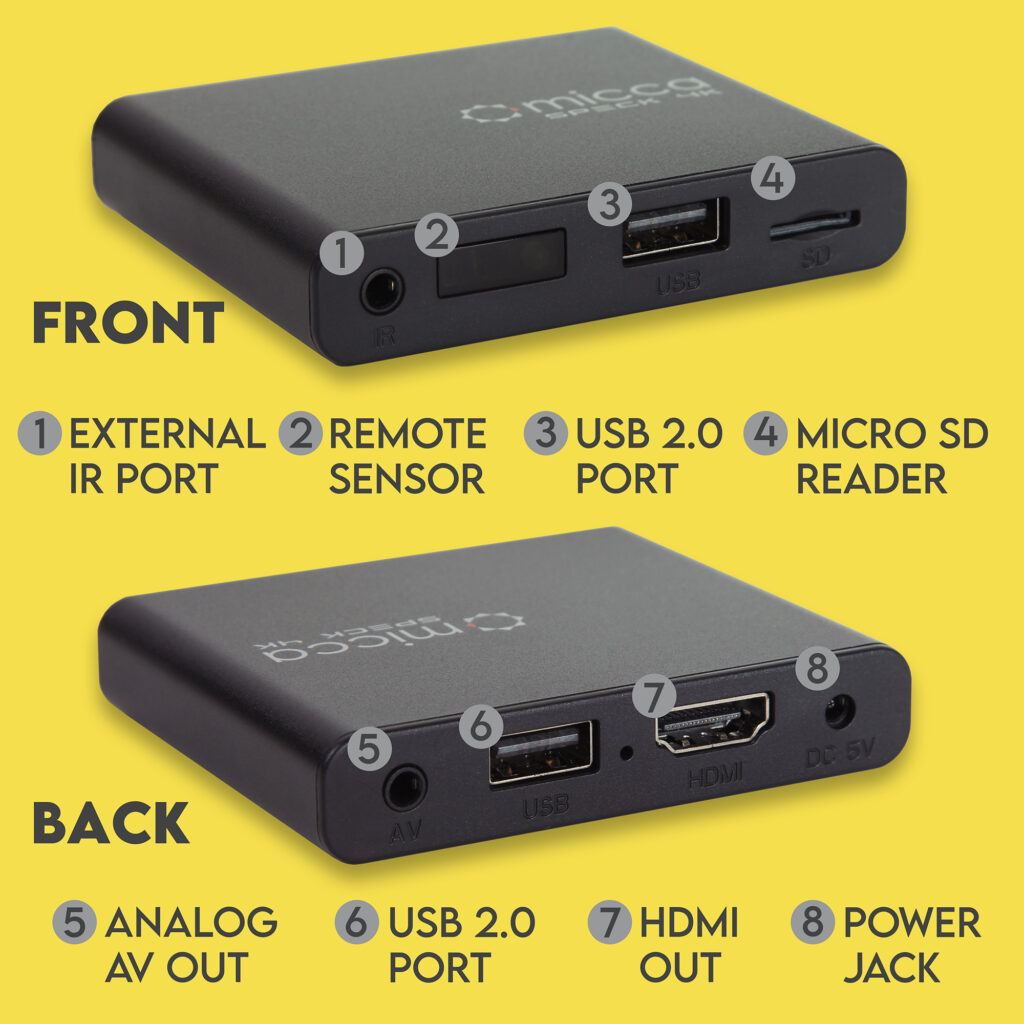
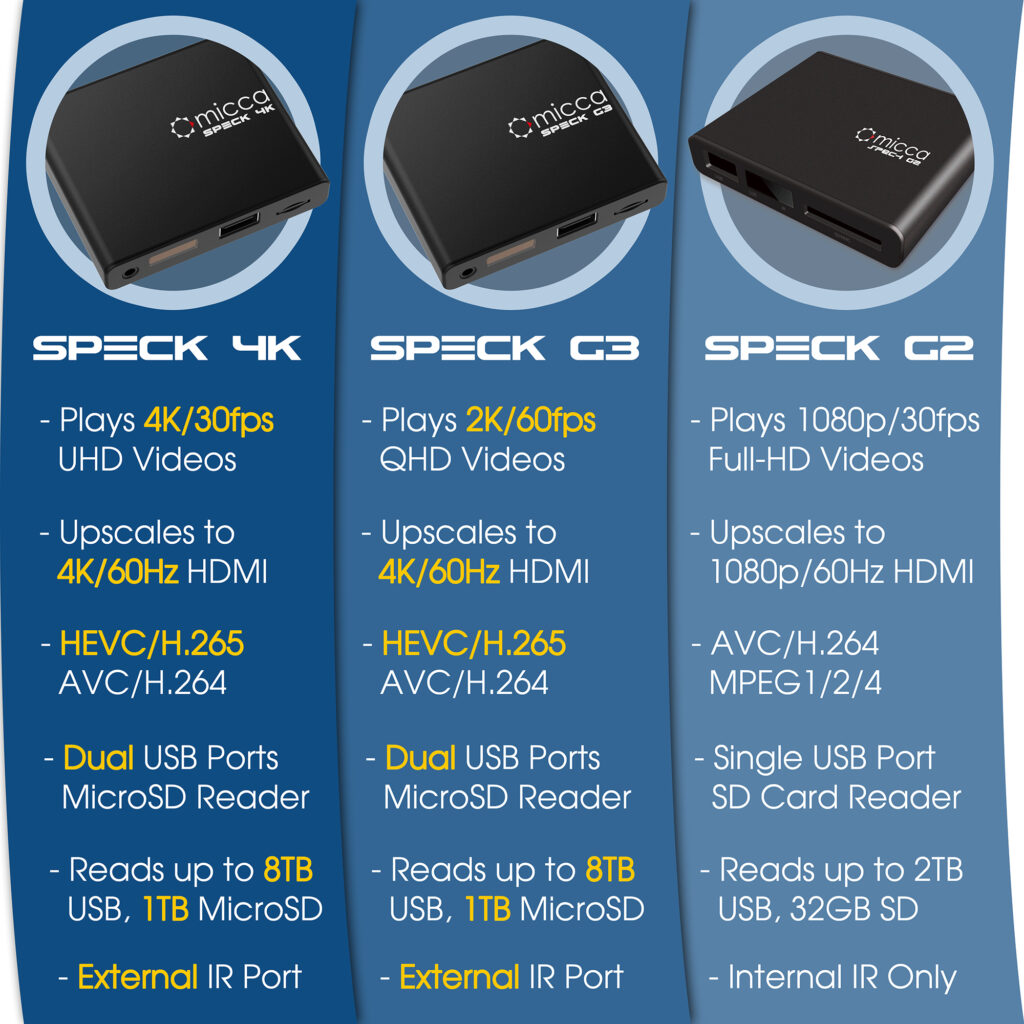
Feature Highlights:
MAKE YOUR TV SMARTER – Enhance any TV with the ability to play videos, music, and photo slideshows from a USB drive or MicroSD Card! It’s so simple and intuitive – anyone can use it. The Micca Speck G3/4K is amazingly compact and affordable, get one for each TV in the house!
PLAYS 2K/4K VIDEOS – Works with TVs old and new! Smoothly plays videos up to 2560×1440@60fps for Speck G3 and up to 4096×2304@30fp for Speck 4K, both with UHD 4K/60Hz HDMI output. Sharp and clear video and audio in pure digital format, compatible with 4K and 1080p TVs, projectors, and monitor displays. Composite AV output for use with analog TVs or for sending sound to a stereo system.
DUAL USB AND MICRO SD READER – Play media files from USB flash drives and USB hard drives up to 8TB, or microSD cards up to 1TB. Supports FAT/FAT32, exFAT and NTFS file systems. Compatible with wireless air mouse remotes for non-line-of-sight control so that the player can be hidden away!
SIMPLE DIGITAL SIGNAGE – Automatic video playback with endless repeat and looping, and the ability to resume from the last stopping point. Configurable 90/180/270 degree video output rotation. Great for digital signage applications such as restaurant menu boards, lobby welcome videos, art and museum installations.
| Video | Codec | Resolution/Bitrate |
| H.265/HEVC, H.264/AVC, MPEG1/2/4, VC-1 | ||
| Files: MKV, AVI, MOV, MP4, MPG, VOB, M2TS, TS | ||
| Music | Formats: MP3, OGG, WAV, FLAC, APE | |
| Bit rate: 32kbps – 320kbps | ||
| Photos | Formats: JPG, GIF, BMP, PNG, TIF | |
| Video Output | Analog AV: 720×576 (PAL), 720×480 (NTSC) | |
| HDMI: 720p, 1080p, 2160p | ||
| Audio Output | Analog Stereo | |
| HDMI PCM, Bitstream | ||
| External Storage | Supports USB flash and hard drives using FAT/FAT32, exFAT, NTFS file system up to 8TB | |
| Supports micro SD memory cards using FAT/FAT32, exFAT, NTFS file system up to 1TB | ||
| Dimensions | 3”(W) x 2.5”(L) x 0.6”(H) | |
| Weight | 5 ounces | |
| Power | AC 90-230V, 50/60Hz, DC 5.2V 2A | |
What’s Included:
- Micca Speck Portable Digital Media Player
- IR Remote Control
- 3.5mm to 3 RCA AV Out Cable
- 110-240V AC Adapter
User’s Manual:
Micca Speck G3/4K User’s Manual (opens in a new tab/window)
Firmware:
Micca Speck G3/4K Firmware Version 2.0.3
Installation Instructions:
- Download the firmware file and open it to find the “update.zip” file inside.
- Use an empty USB drive or microSD card, 32GB or smaller, with FAT32 file system.
- Copy the update.zip file onto the USB drive or microSD card.
- Power off the Speck G3/4K player, plug in the USB drive or microSD card, and power the player on.
- Wait for the automatic firmware update prompt – it may take 20-30 seconds to appear.
- Confirm to install the firmware update.
- Wait for the firmware update to complete, which may take up to 10 minutes.
- Delete the update.zip file from the USB drive or microSD card.
Relase Notes:
- New setting option for switching between thumbnails view and list view for browsing Video, Photo, and Music files
- New feature for adding a translucent background to subtitles to improve legibility
- Removed 4096x2160p-30fps display mode to prioritize 3840x2160p-60fps display mode
Known Issues:
- Does not play DVD ISO files or DVD Folders
- HEVC encoded videos may not play in 90, 180, and 270 degree screen rotations
- SUB-IDX subtitles remains on the screen after dialogue has ended
Micca Speck G3/4K Firmware Version 2.0.2
Installation Instructions:
- Download the firmware file and open it to find the “update.zip” file inside.
- Use an empty USB drive or microSD card, 32GB or smaller, with FAT32 file system.
- Copy the update.zip file onto the USB drive or microSD card.
- Power off the Speck G3/4K player, plug in the USB drive or microSD card, and power the player on.
- Wait for the automatic firmware update prompt – it may take 20-30 seconds to appear.
- Confirm to install the firmware update.
- Wait for the firmware update to complete, which may take up to 10 minutes.
- Delete the update.zip file from the USB drive or microSD card.
Relase Notes:
- New UI for Video, Photo, and Music browsing mode that shows thumbnails
- Fixes issue of image displays not updating under certain duplicate file name situations
- New Video Pause Info setting to enable/disable the display of video information
- Pause icon during paused slideshow will auto hide after a few seconds
- Other improvements to performance and stability
Known Issues:
- Does not play DVD ISO files or DVD Folders
- HEVC encoded videos may not play in 90, 180, and 270 degree screen rotations
- SUB-IDX subtitles remains on the screen after dialogue has ended
Micca Speck G3/4K Firmware Version 1.1.21
Installation Instructions:
- Download the firmware file and open it to find the “update.zip” file inside.
- Use an empty USB drive or microSD card, 32GB or smaller, with FAT32 file system.
- Copy the update.zip file onto the USB drive or microSD card.
- Power off the Speck G3/4K player, plug in the USB drive or microSD card, and power the player on.
- Wait for the automatic firmware update prompt – it may take 20-30 seconds to appear.
- Confirm to install the firmware update.
- Wait for the firmware update to complete, which may take up to 10 minutes.
- Delete the update.zip file from the USB drive or microSD card.
Relase Notes:
- Prev/Next button in Random playback mode will go to the Prev/Next random media file
- Fixes an issue where certain file names containing only numeric digits cannot be displayed correctly
- Fixes an issue where the player cannot read all files from certain exFAT formatted drives
- Other improvements to performance and stability
Known Issues:
- Does not play DVD ISO files or DVD Folders
- HEVC encoded videos may not play in 90, 180, and 270 degree screen rotations
- SUB-IDX subtitles remains on the screen after dialogue has ended
Micca Speck G3/4K Firmware Version 1.1.20
Installation Instructions:
- Download the firmware file and open it to find the “update.zip” file inside.
- Use an empty USB drive or microSD card, 32GB or smaller, with FAT32 file system.
- Copy the update.zip file onto the USB drive or microSD card.
- Power off the Speck G3/4K player, plug in the USB drive or microSD card, and power the player on.
- Wait for the automatic firmware update prompt – it may take 20-30 seconds to appear.
- Confirm to install the firmware update.
- Wait for the firmware update to complete, which may take up to 10 minutes.
- Delete the update.zip file from the USB drive or microSD card.
Relase Notes:
- Adds support for MTS video files
- Other improvements to performance and stability
Known Issues:
- Does not play DVD ISO files or DVD Folders
- HEVC encoded videos may not play in 90, 180, and 270 degree screen rotations
- SUB-IDX subtitles remains on the screen after dialogue has ended
Micca Speck G3/4K Firmware Version 1.1.19
Installation Instructions:
- Download the firmware file and open it to find the “update.zip” file inside.
- Use an empty USB drive or microSD card, 32GB or smaller, with FAT32 file system.
- Copy the update.zip file onto the USB drive or microSD card.
- Power off the Speck G3/4K player, plug in the USB drive or microSD card, and power the player on.
- Wait for the automatic firmware update prompt – it may take 20-30 seconds to appear.
- Confirm to install the firmware update.
- Wait for the firmware update to complete, which may take up to 10 minutes.
- Delete the update.zip file from the USB drive or microSD card.
Relase Notes:
- Fixes an issue of certain video files becoming out of sync between video and audio.
- Other improvements to performance and stability
Known Issues:
- Does not play DVD ISO files or DVD Folders
- HEVC encoded videos may not play in 90, 180, and 270 degree screen rotations
- SUB-IDX subtitles remains on the screen after dialogue has ended
Micca Speck
Mac Computer Owners – Photo and Video Playback Issues
Mac computers are great but Mac owners often report odd behaviors when they share a SD card or USB drive between a Mac and non-Mac devices, including Micca digital photo frames and media players. The issue is most likely caused by the following:
If you are using a Mac to copy photos or videos to a SD card or USB drive, it will create a small thumbnail in the same folder as each image/video, preceded by a “._” in the file name. These extra files cause problems on non-Apple devices. There are utilities like this one:
http://www.zeroonetwenty.com/blueharvest/
To remove these extraneous files so that non-Apple devices can work correctly. It is also possible to erase these files without running a utility, such as described in the following web tutorial:
http://www.wikihow.com/Remove-.Ds_Store-Files-on-Mac-Os-X
Posted in: Digital Media Players, Digital Photo Frames, Micca 1186-Based Media Players - EP600 G2, EP950, Micca EP100, Micca M1003Z, M1203Z, M1503Z, Micca M1709Z, Micca M707Z, M808Z, M1010Z, Micca MPLAY-HD, Micca MPLAY-HD WLAN, Micca Neo Series Photo Frames, Micca Speck
SD cards or USB drives not showing up on media players
Micca digital media players support the vast majority of commonly used storage device types, including SD cards and USB hard drives. There are, however, limitations that users should be aware of. The SD cards and USB drives must meet the following requirements:
- Not password protected or encrypted.
- SD cards up to 32GB, USB drives up to 2TB.
- USB 3.0 drives are supported if the drive is USB 2.0 compatible.
- File system must be FAT/FAT32 or NTFS.
- Partition type must be Master Boot Record (MBR).
While it is easy to determine the size of a drive, users often don’t know what file system or partition type is being used. This tutorial shows how a Windows PC can be used to find out the file system and partition type of a drive.
Dowload Tutorial:
Determining Drive Properties Tutorial (opens in a new tab/window)
Mac Users:
Below is an excellent tutorial on how to determine drive properties on OS X:
http://www.dummies.com/how-to/content/how-to-view-information-about-partitions-and-volum.html
Posted in: Micca 1186-Based Media Players - EP600 G2, EP950, Micca EP100, Micca MPLAY-HD, Micca MPLAY-HD WLAN, Micca Speck
How to remux videos into MKV format
The MKV container file format is quickly becoming the most popular choice for digital videos. Consequently, MKV is also the format that is best supported by HD-capable Micca digital media players. This tutorial will show you how to quickly convert a video that’s currently in a different container file format to MKV. It is also useful to remux an existing MKV file to fix any errors that may have been in the original file.
First, download and install the free MKVToolnix software from the following URL:
http://www.bunkus.org/videotools/mkvtoolnix/downloads.html#windows
After installing the the software, run the “mkvmerge GUI” program that’s now available from your Start->Programs->MKVToolnix menu. Follow the directions below to quickly convert videos into MKV:
- Click on the “add” button and find the video file you want to convert into MKV. Once the video has been succsfully added, it’s audio and video tracks will be shown in the “Tracks, chapters and tags” box.
- Click to select the video track in the “Tracks, chapters and tags” box. The video track is identified by “type: video” in parenthesis.
- With the video track highlighted, go to the “Extra options” tab and change the “Compression” field value to “none”. This is a very important step.
- In the “Output filename” box, specify the output file. By default, the program will use the same directory and file name as the original file but with MKV file extension.
- Click “Start muxing” button to begin the conversion. Depending on the size of the original video file, this process should take just a few minutes.
- Click on the “Ok” button once the conversion is complete.
And that’s all there is to it. The resulting file should be about the same size as the original and there is no decrease in video or audio quality. MKVMerge is a very powerful tool and it can do a lot more than what’s described in this guide. For example, it is also possible to add additional audio and subtitle tracks to the video file by adding them in step 1. If these additional capabilities are of interest to you, read the help documentation that is supplied with the software for more information.
Posted in: Micca 1186-Based Media Players - EP600 G2, EP950, Micca EP100, Micca MPLAY-HD, Micca MPLAY-HD Mini, Micca MPLAY-HD WLAN, Micca Speck
Micca Speck Does Not Recognize Certain Seagate Expansion Desktop USB Hard Drives
The Micca Speck does not recognize certain Seagate Expansion desktop USB hard drives including the following models:
- STBV2000100 – 2TB USB 3.0
- STBV1000100 – 1TB USB 3.0
The affected Seagate Expansion USB hard drives use their own power supply and has a delayed turn-on mechanism that is not supported by the Micca Speck media player. When connected to the Micca Speck, the Speck detects the drive but is not able to read its contents or play any media files from it. Older Seagate Expansion desktop USB hard drives, as well as Seagate portable USB hard drives are not affected by this compatibility issue.
There has been no reports of incompatibility with other brands of external desktop USB hard drives such as Western Digital or Toshiba. This issue is unique to the specific Seagate USB hard drive models listed above.
Posted in: Micca Speck
What’s the difference between Micca MPLAY-HD Mini and Micca Speck G2?
Micca recently released the new MPLAY-HD Mini digital media player, positioned as an affordable upgrade to the Speck G2. The MPLAY-HD Mini shares the same compact aluminum design, but offers a host of upgrades in capability with only a modest increase in price. Here are the main improvements that the MPLAY-HD Mini has over the Speck G2:
Please note that despite these improvements, the MPLAY-HD Mini still has some limitations that are important to keep in mind: it does not play HEVC/H.265 videos, 10-bit MKV, or videos with resolution higher than 1920x1080p, such as 4K videos.
| MPLAY-HD Mini | Speck G2 | |
| Playback image quality | Excellent | Good |
| Video bit-rate support | 40mbps | 10mbps |
| MP4 video file size | No size limit | 4GB max |
| ISO video file support | DVD and BD | Not supported |
| HDMI audio output | PCM stereo, 5.1/7.1 surround | PCM stereo only |
| Subtitle support | SRT, SUB+IDX, PGS | SRT |
| Video resume play | Automatic resume on power up | Manual resume by selection |
| Hard drive support | Up to 4TB | Up to 2TB |
| File system support | FAT/FAT32/exFAT, NTFS, HFS+, EXT3 | FAT/FAT32, NTFS |
| USB host ports | 2 | 1 |
| Memory card reader | microSD | SD |
| External IR sensor jack | Yes | No |
Posted in: Micca MPLAY-HD Mini, Micca Speck
Micca Speck G2 Not Reading USB Hard Drives
Micca Speck G2 supports USB flash drives and USB hard drives that are 2TB or smaller in size. In the past, all drives smaller than 2TB have shipped from the factory with MBR partition tables, which is supported nearly universally by computers and electronics. Recently, manufacturers like Western Digital and Seagate have begun shipping newer USB hard drives with GPT partition table even for drives that are 2TB or smaller. This has caused numerous issues with users of older version of Windows, various backup software, and many media devices like the Micca Speck G2. When the Micca Speck G2 encounters such a drive, it will show the USB drive letter, but not be able to read any of the files.
For everyday users, there is no practical difference between MBR and GPT, especially when it comes to a USB hard drive that is used to carry large amount of files in bulk. Therefore, this guide shows you how you can take a USB hard drive that is 2TB or smaller, check to see if it is using GPT, and switch it to using MBR instead. Doing so not only makes the drive compatible with the Micca Speck G2, but with all other computers and electronics.
1. Check The Partition Type We start by checking the partition type of the drive you have.
- Press the “Windows” key on the keyboard and type “Drive Management” and press enter. This will open the Disk Management window. Your USB drive will be listed as one of the drives detected.
- Right click on the square that matches your USB drive and select “Properties”, in the example below, our USB drive is “Disk 2”.
- In the pop up window, switch to the “Volume” tab. If the drive is using MBR partition, it will have a partition style of “Master Boot Record”. If instead it uses GPT, it will have a partition style of “GUID Partition Table”. In our example below, the partition style is GPT, meaning the drive should be converted to MBR in order to be used with the Micca Speck G2.
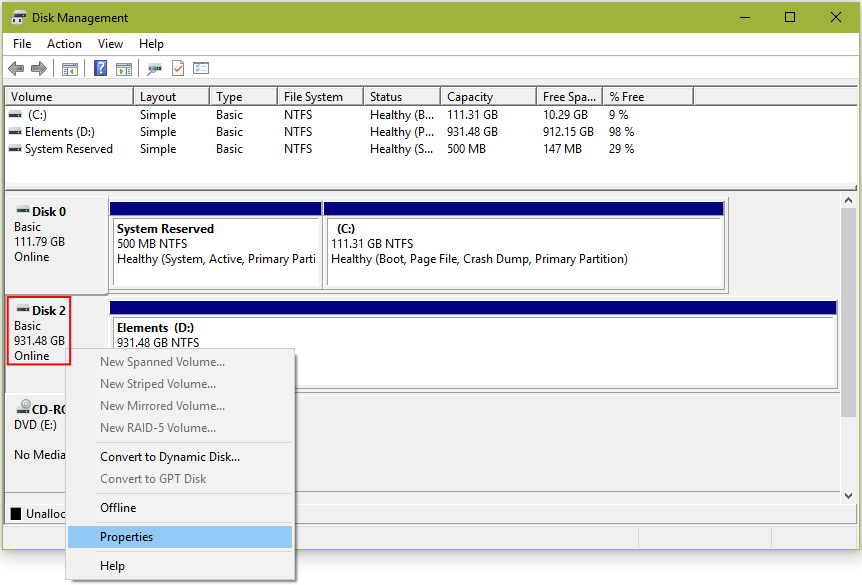
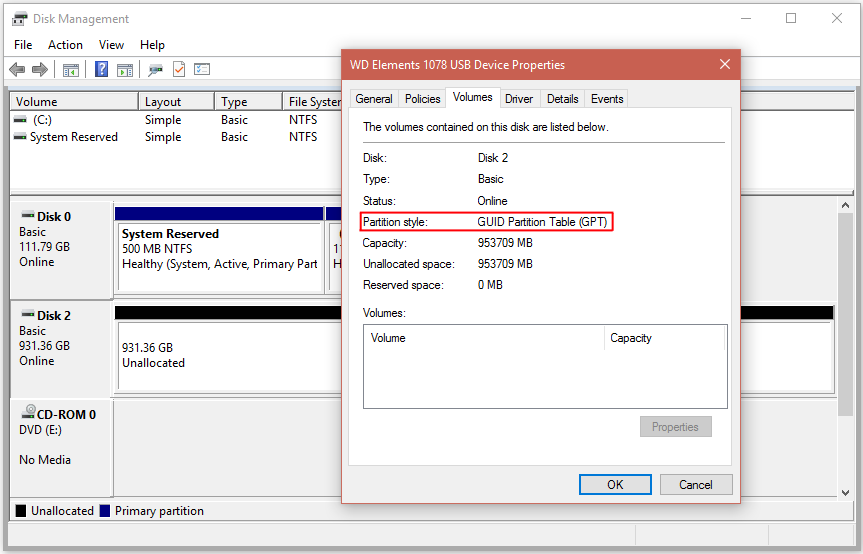
2. Backup Your Files Changing the partition table from GPT to MBR will erase the content of the drive, so be sure to start by copying the files off of the drive to a safe location. You will copy the files back onto the drive when done.
3. Change Partition Style to MBR Once you are sure you’ve backed up all your data in a safe place, we can begin changing the partition type. Do not proceed unless you are absolutely certain that the data has been copied somewhere safe.
- In the Drive Management window, right click on the block that represents your USB hard drive’s partition and select “Delete Volume…”. You will be asked to confirm the action. Do not proceed unless you are absolutely certain that the data has been copied somewhere safe.
- Right click on the square that represents your USB drive and select “Convert to MBR Disk”, as illustrated in the photo below:
- Once the conversion is done, you need to create the primary partition. Do so by right clicking on the block that says “Unallocated” and select “New Simple Volume”, as illustrated below:
- Click “Next” through all the steps in the new volume creation wizard and click Finish to complete. The computer will take a bit of time creating the new partition and giving it a quick format.
- You can confirm by checking the drive partition style again that it now shows “Master Boot Record”, as illustrated below.
- Now you can copy all your files back onto the drive and use it with the Micca Speck G2 without any issues!
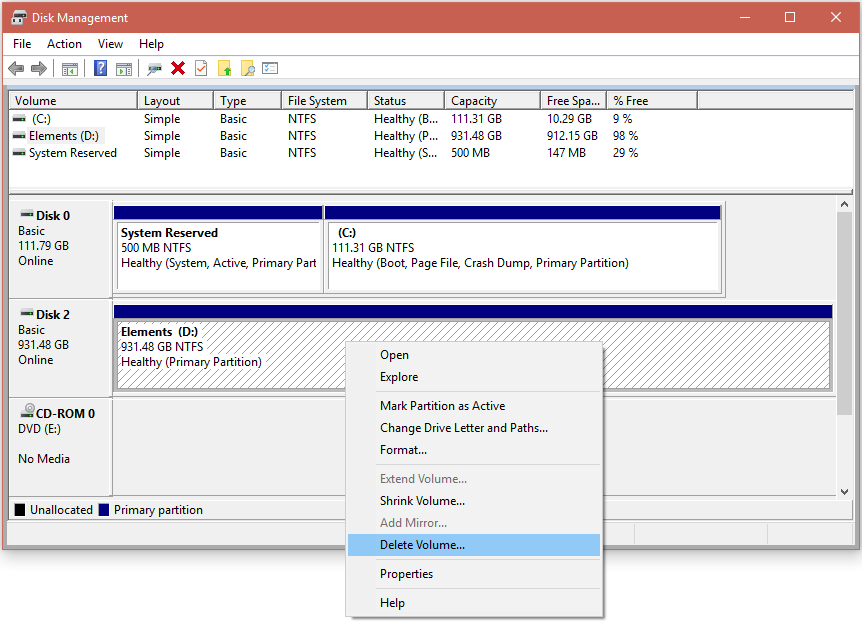
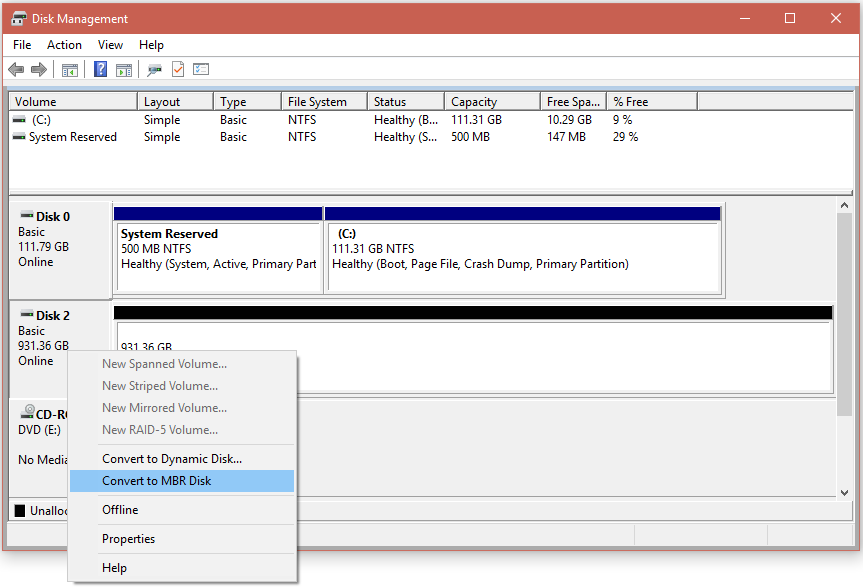
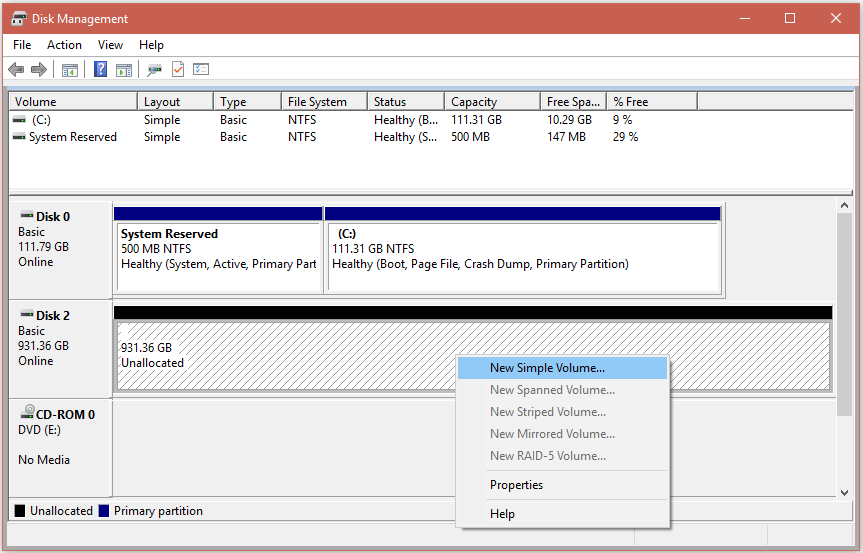
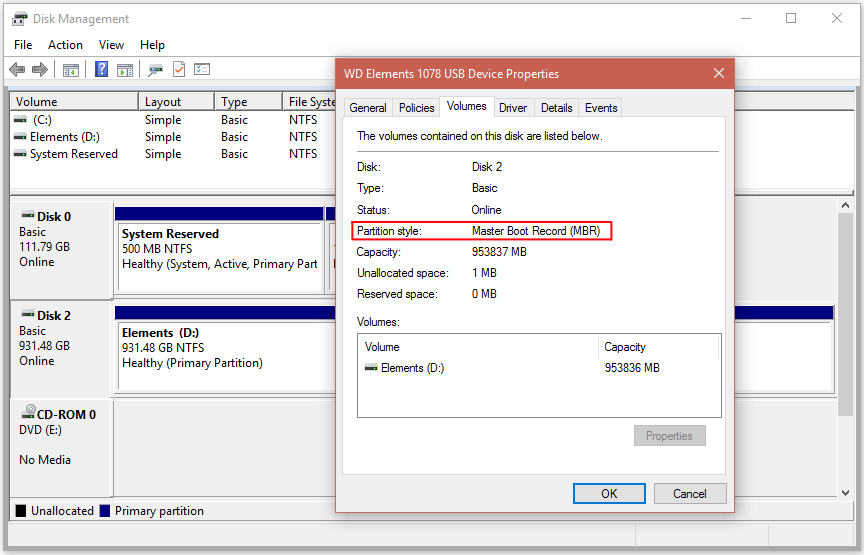
Posted in: Micca Speck
Deleted videos, photos, or music files still show up
If you’ve deleted some media files from a USB drive or SD card, yet the deleted files still show up, the issue is likely caused by the presence of Windows Recycling Bin or MacOS Trash Can folders on the USB drive or SD card. Fixing this issue requires emptying the contents of these folders permanently.
Warning: The purpose of the Windows Recyclin Bin and MacOS Trash Can is to allow you to recover previously deleted files that you later need. The steps below permanently empties these folders so you will not be able to recover these files again. Proceed only if you are certain that you do not need these files.
To empty the Recycling Bin folder created by a Windows PC, plug your USB drive into the PC, wait for the drive to show up in Windows Explorer. Right click on the drive and select “Properties”. In the “General” tab, click on “Disk Cleanup”. Place a check mark for “Recyclin Bin”, and click “OK”. This will delete the contents of the Recycling Bin on the USB drive.
For MacOS, there is unfortunately no built-in way to empty just the Trash Can on a USB drive; all Trash Can folders on all drives are emptied by default. To empty the Trash Can for all drives, plug your USB drive into the Mac, wait for it to mount. Next choose Empty Trash under the Finder menu or press Command+Shift+Delete. A pop up will ask you to confirm that you wish to empty the Trash Can.
Posted in: Digital Media Players, Digital Photo Frames, Micca 1186-Based Media Players - EP600 G2, EP950, Micca EP100, Micca M1003Z, M1203Z, M1503Z, Micca M1709Z, Micca M707Z, M808Z, M1010Z, Micca MPLAY-HD, Micca MPLAY-HD Mini, Micca MPLAY-HD WLAN, Micca Neo Series Photo Frames, Micca Speck
720p/1080p HD Video Encoding Tutorial
Encoding a video in 720p or 1080p high definition format is easier than ever thanks to the availability of free and well working tools like Handbrake. This tutorial will show you how to use this wonderful tool to recode videos into popular MP4 or MKV formats for playback on Micca products that support 720p and 1080p video playback. To start, download and install Handbrake suitable for your operating system from the link below:
https://handbrake.fr/downloads.php
At the time of this tutorial, the Handbrake version is 1.1.2, your screen might look slightly different but should be very similar.
Step 1 – Open the source video
After installing Handbrake, run it and the following window should be displayed. Drag and drop your source video into the Handbrake window to open it.
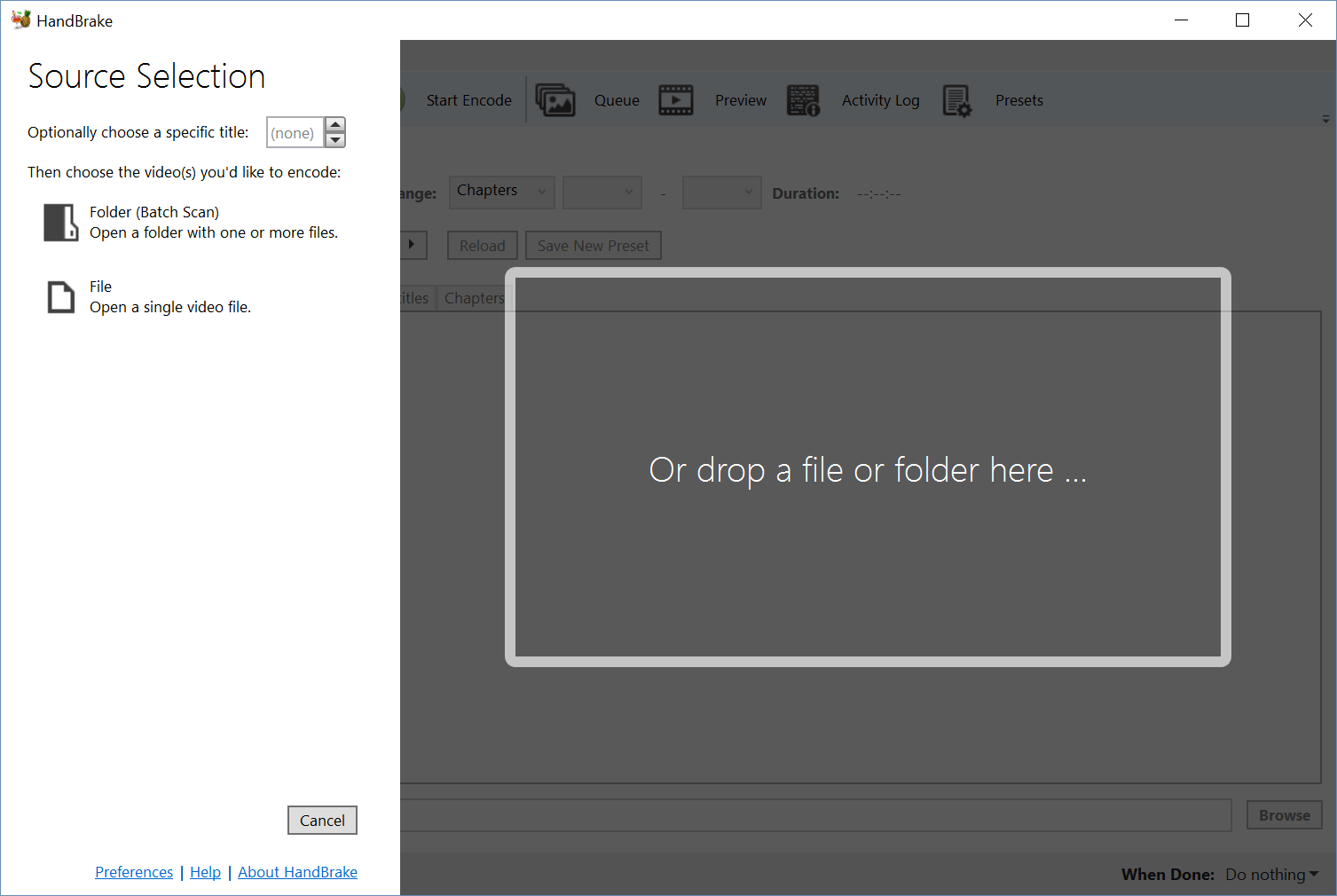
Step 2 – Select a encoding preset Handbrake as numerous convenient presets built-in that are especially useful for our purpose. Choose preset according to the following:
If you want MKV videos (preferred):
If you want MP4 videos:
For this tutorial we are choosing Matroska->H.264 MKV 1080p30 as shown in the image below
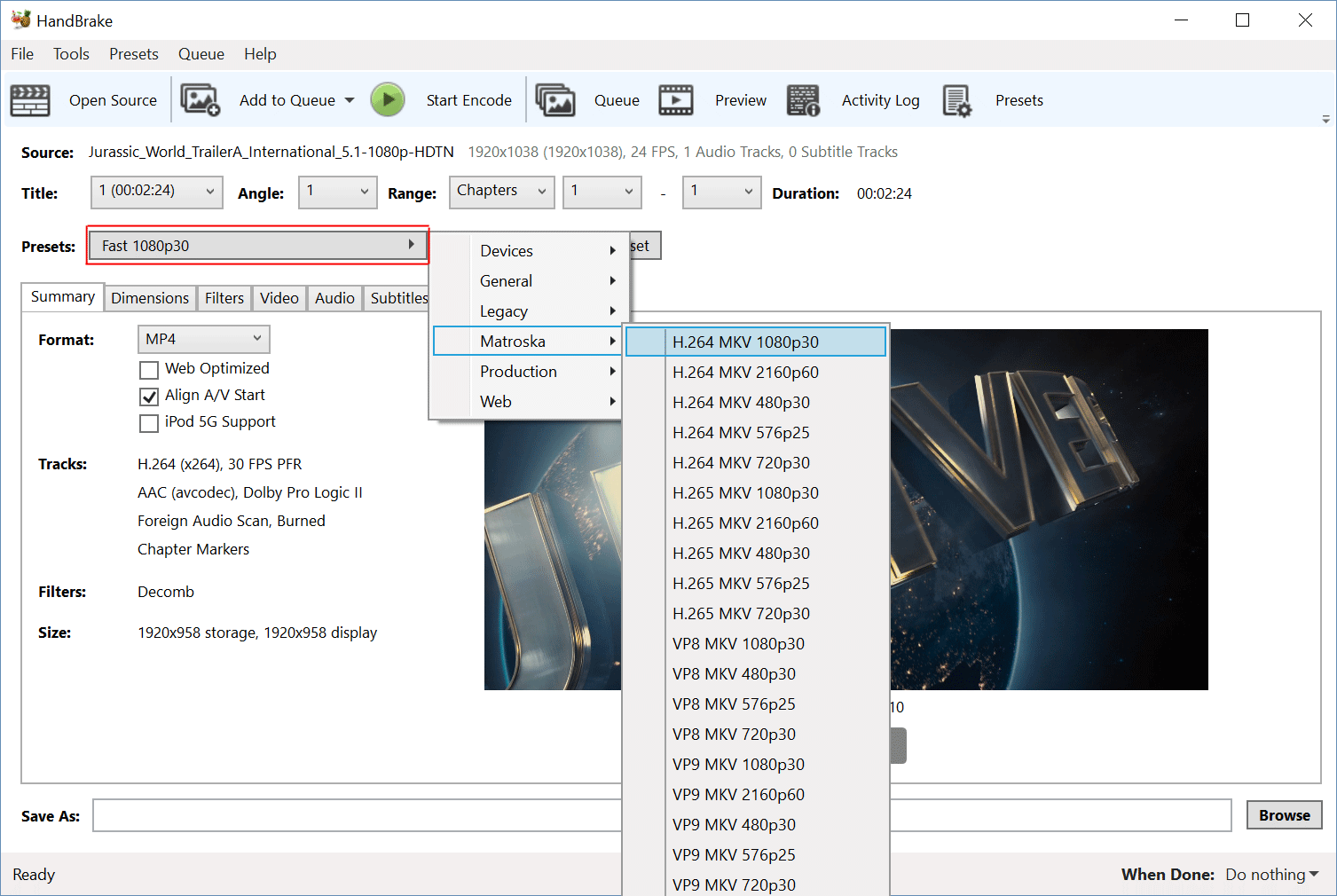
Step 3 – Adjusting Dimensions Click on the Dimensions tab and make the following changes:
The window should look similar to the following:
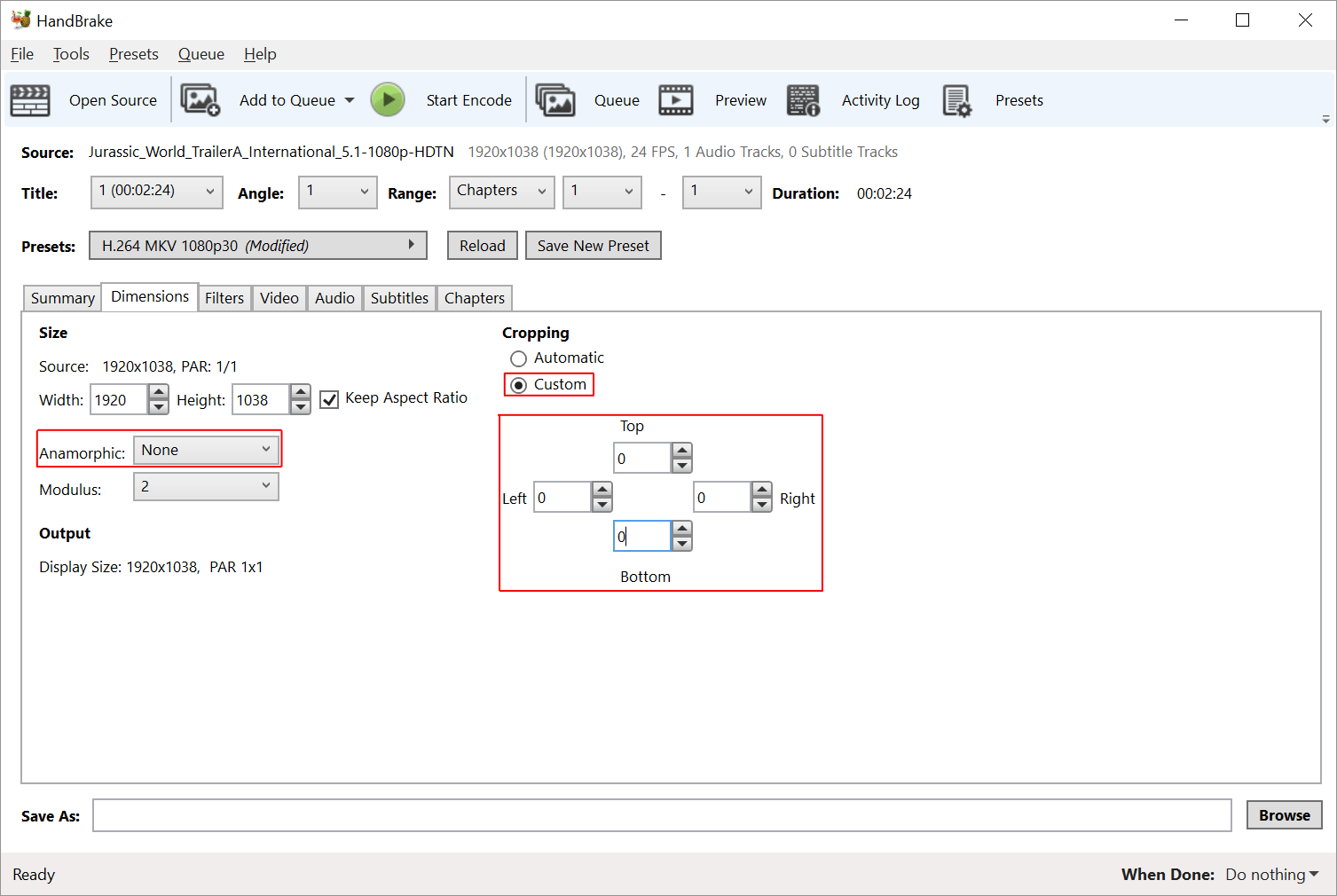
Step 4 – Saving your new video
Almost done! Click on the Browse button and choose a file name and location to save to. Finally, click on the Start Encoding button to begin encoding the new video. After the encoding is done, the new video should play very well on your Micca player.
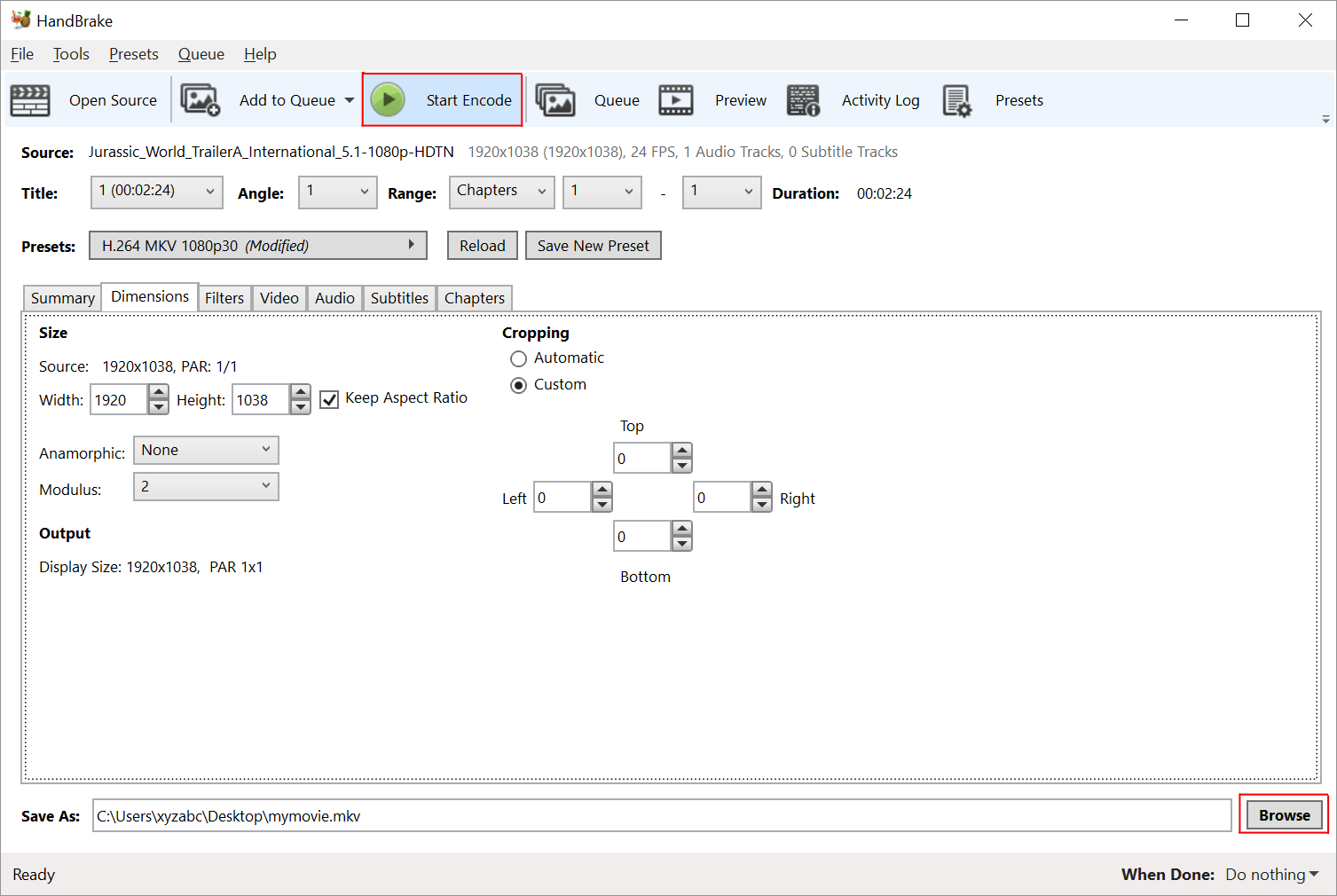
Other Settings Handbrake is a powerful piece of software and there are many other possible settings available that are beyond the scope of this tutorial. Here’s a brief introduction on what the settings in the other tabs do:
Filters: Special video processing filters that can be used to remove noise and artifacts from the video.
Video: Encoding settings for the video track. The Quality setting on this tab can be useful even for novice users. Constant quality is the preferred setting. Make small adjustments to this value and do not change more than 2-3 away from the default value.
Audio: Encoding settings for the audio track, can be useful if you want to include multiple sound tracks or have surround sound tracks.
Subtitle: By default Handbrake does not add any subtitles. You can choose to add in subtitles that exists from the source video, or by importing SRT subtitles.
Chapter: By default Handbrake will retain any chapter marks that were in the original video. You can also import chapter marks from an external source if available.
Posted in: Micca 1186-Based Media Players - EP600 G2, EP950, Micca EP100, Micca MPLAY-HD, Micca MPLAY-HD Mini, Micca MPLAY-HD WLAN, Micca Speck
Micca Speck G3/4K Firmware Update Recovery Procedure
In the process of performing firmware updates for the Micca Speck G3/4K digital media players, if the process is interrupted or if an error occurs in the upgrade process, the media player may become stuck in an intermediate state and not complete the firmware update process. In order to recover the media player from this state, please follow the instructions below.
These procedures require a Windows PC and a microSD card between 2GB to 32GB in size. This process will not work with USB drives or microSD cards larger than 32GB.
1. Download and Unpack the Software Package
- Download the software package using the button below:
- Right click on the downloaded software package and select “Extract All” and then confirm by clicking on the “Extract” button:
- The file explorer should automatically display the extracted files:
- Double-click on the SD_Firmware_Tool application to run it.
Download <<< Click to Download!
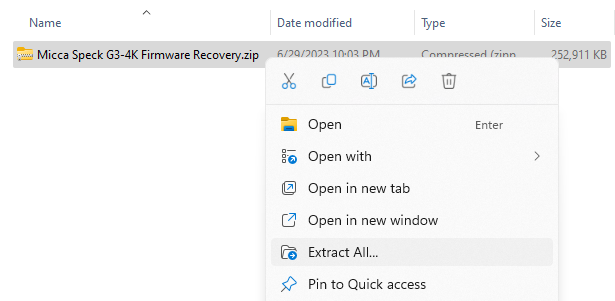
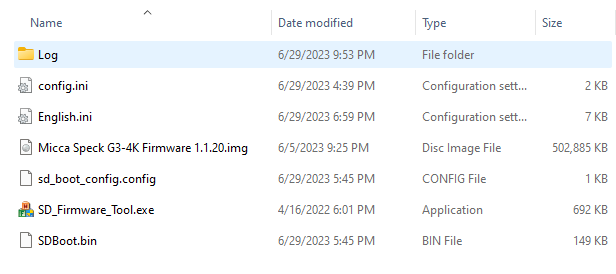
2. Create Firmware Update Drive
- Insert the microSD card into a card reader on your computer.
- In the firmware update drive tool window, follow the steps 1, 2, and 3 as guided on screen. Make sure you have selected the correct microSD card in step 1. Selecting the wrong drive will cause permanent data loss.
- Click on the Write SD button to write the firmware to the microSD card. A confirmation prompt will be displayed. Make sure you have selected the correct microSD card in step 1. Selecting the wrong drive will cause permanent data loss. Do not proceed unless you are absolutely certain that the correct microSD card has been selected.
- Once the firmware update drive has been created on the microSD card, a confirmation will be displayed:
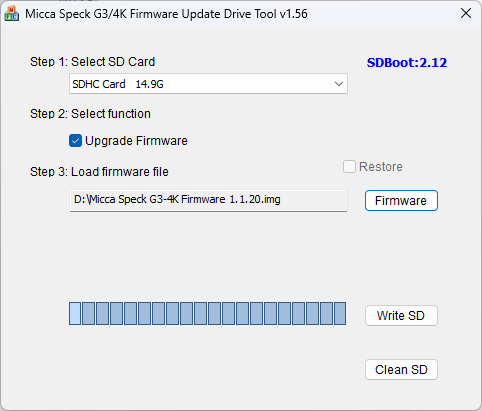
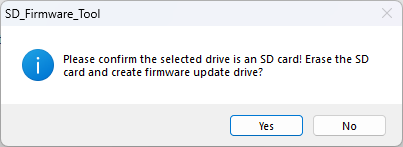
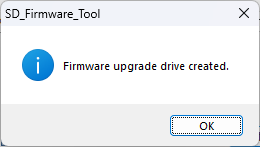
3. Upgrade Firmware
- Unplug power cable and remove all USB drives from the Micca Speck G3/4K digital media player.
- Insert the microSD card with firmware update into the Micca Speck G3/4K digital media player.
- Plug in the power cable to the media player and the firmware update process will begin:.
- After a few minutes, the firmware update will prompt the user to remove the microSD card. At this time, remove the microSD card from the player:
- For the next stage, the player will take some time to apply the firmware update. During this time, the Micca logo will be displayed on screen. This process may take up to 10 minutes, do not unplug power or otherwise interrupt the process.
- Once the firmware recovery process is complete, the main menu will be displayed:
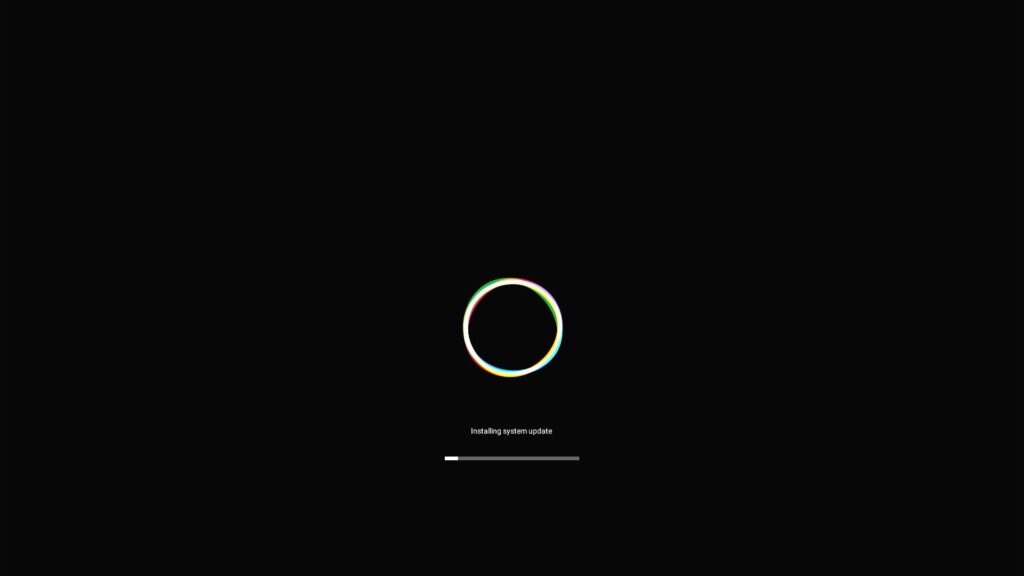

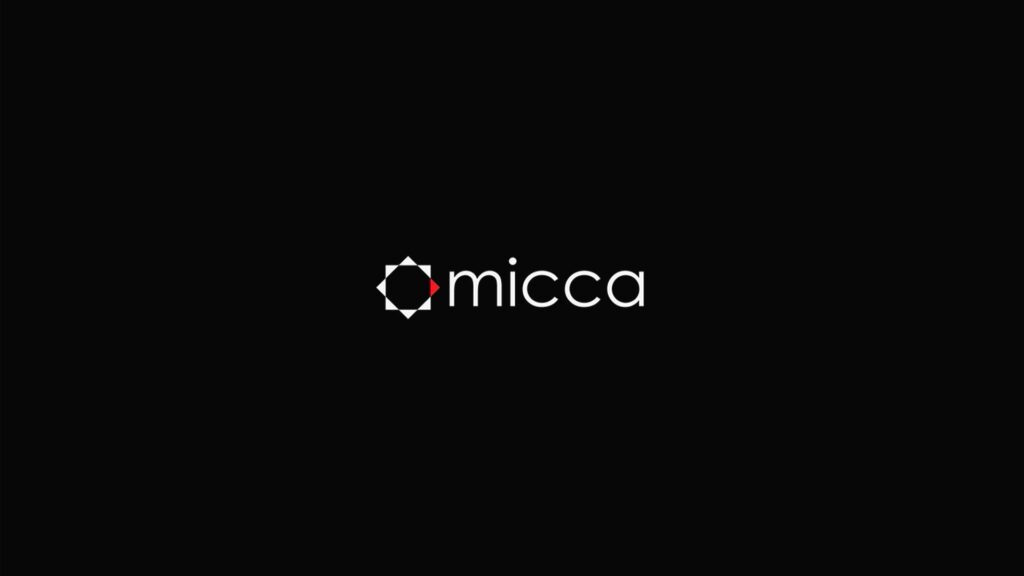
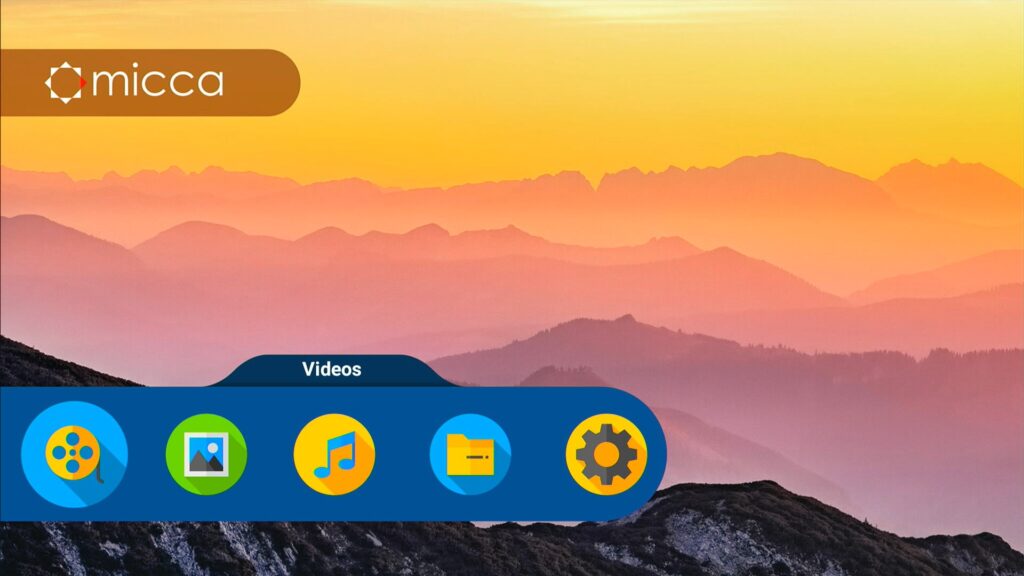
At this point, the firmware recovery is complete, and you may wish to apply additional firmware updates using the normal firmware update process.
Posted in: Micca Speck
